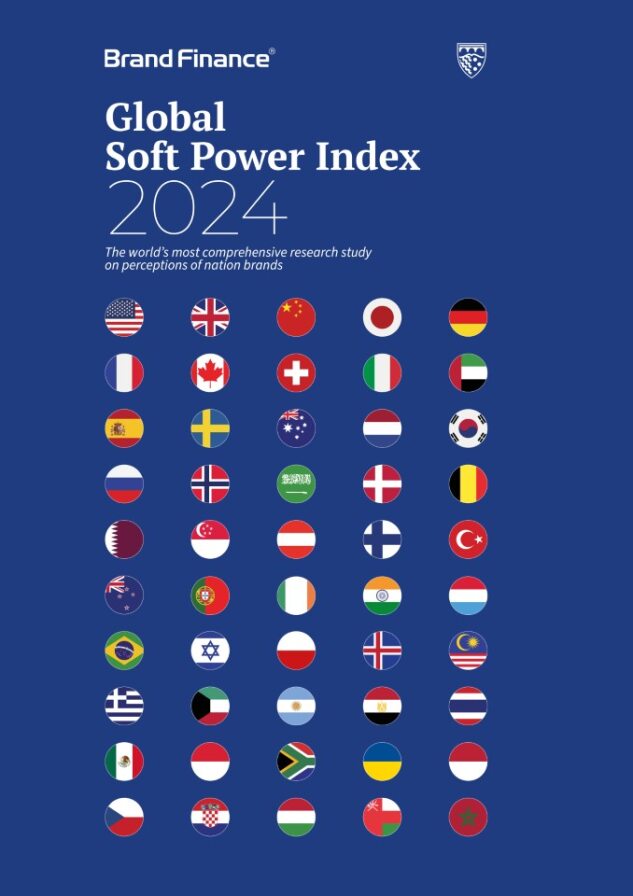This article was originally published in the Global Soft Power Index 2024

Associate Fellow,
Saïd Business School,
University of Oxford
The political scientist Joseph Nye, who popularised the term ‘Soft Power’, argued in his book The Future of Power (2011) that a nation’s Soft Power is derived from three principal resources: ‘its culture (in places where it is attractive to others), its political values (when it lives up to them at home and abroad), and its foreign policies (when others see them as legitimate and having moral authority).’ These resources can make a nation more attractive to others and co-opt – rather than coerce – them into aligning with their interests.
Since the launch of the Global Soft Power Index in 2020 we have seen a more complex and dynamic picture emerge, particularly in the intersection of Soft Power and nation branding. While nation branding efforts are typically focused on improving performance of a country in attracting, for example, investment and tourists, metrics more usually associated with Soft Power are also being shown to be influential in these areas.
As a result, the overall theme of the Index report and Summit this year is precisely the role of Soft Power in inviting tomorrow’s investment, trade, talent, and tourism, and thus its influence on the global economy. Additional research in this year’s survey asked explicitly about the recommendation by respondents of different nation brands as places to invest in, trade with, work in, study in, and visit.
Sustainability is emerging as a particularly important issue in driving attractiveness of nations in these spaces. Brand attributes reflecting attention to environmental concerns are valuable at a corporate and national level. Additionally, action on climate is a major political issue and global challenge that requires commitment and collaboration across the world to achieve. And the nations that can convince others to cooperate and sign up to global targets and action are those which have and are prepared to wield Soft Power.
This year’s survey also sees an increase in the database with the inclusion of 72 new nations, taking the total to 193, and ensuring that all member states of the United Nations are ranked for the first time. The total number of people interviewed is over 170,000.
As we have seen over the past five years, Soft Power is remarkably ‘sticky’: despite a number of tumultuous events in individual countries, the top of the table remains fundamentally stable. This is likely to be because of entrenched perceptions, and residual reputation and influence. These are properties of developed, larger, countries, although rankings can and do change – as we can see by tracking Germany and China, for example.
Many mid-ranked countries also seem to be holding their positions roughly year on year. However, while historic reputations may play a part in this, many are missing opportunities to increase their Soft Power by not developing comprehensive nation brand strategies and focusing only on a limited number of sectoral based pillars, such as tourism and trade. While it is true that few developed countries appear to have single all-encompassing nation brand plans either, due to their size, state of development, and historic political and economic importance, they naturally cover more of the pillars with their activities than others. They are adept at assessing nation brand sector activities in terms of specific performance, but have not really focused on how powerful Soft Power strategies can also be strong drivers of performance, particularly brand strength and value.

In this, all countries could do well to take a leaf out of the book of countries in the Middle East, three of which – United Arab Emirates, Saudi Arabia, and Qatar – are fast increasing their Soft Power through solid, sustainable strategies. These countries have long been powerful despite their size for economic reasons. However, with deliberate strategies such as The Emirates hosting of EXPO 2020 and COP28, Qatar’s FIFA world cup, and high-profile tourism and sporting campaigns developed under Vision 2030 in Saudi Arabia, they are becoming increasingly influential. They are seizing Soft Power opportunities to define national competitive advantages and change perceptions.
With each iteration of the Index, we can see how more aware of the drivers of Soft Power many nations have become, and how Soft Power delivers on brand strength and value. Perception studies also remind us that they can become entrenched – sticky. It takes deliberate and sustained comprehensive brand strategies, not on just a sector basis, to change them. Unlike in the private sector, there is still room for improvement in nation brand management structures to discover and realise the full potential of perceptions.

